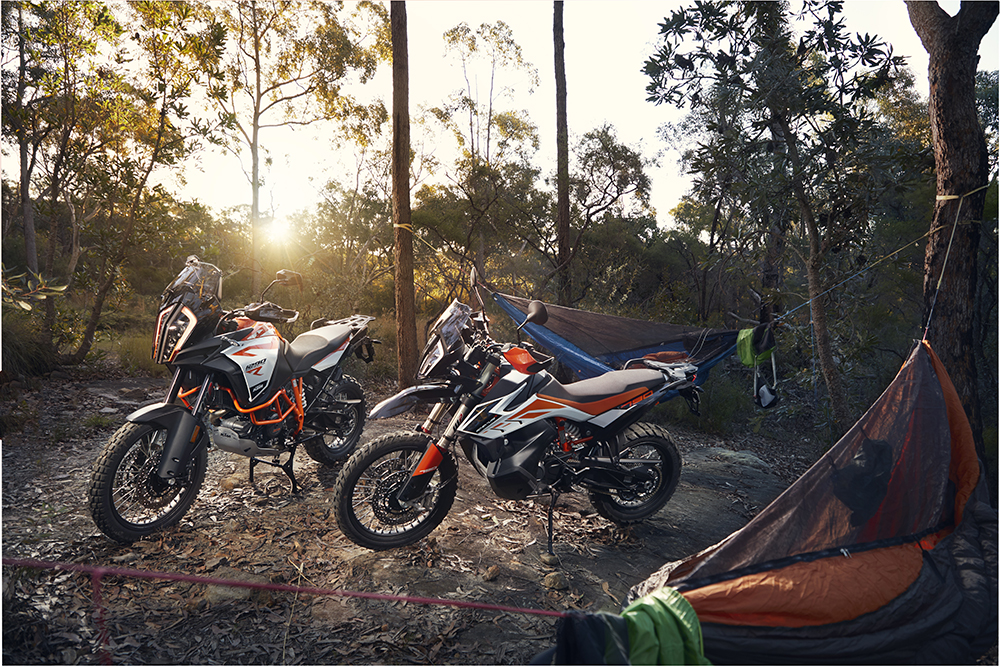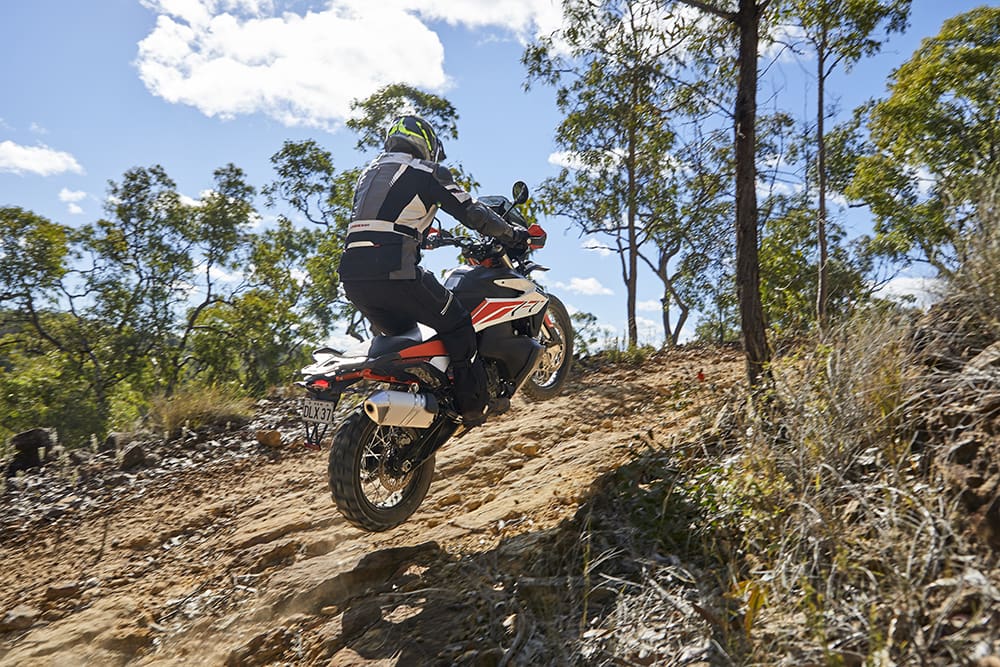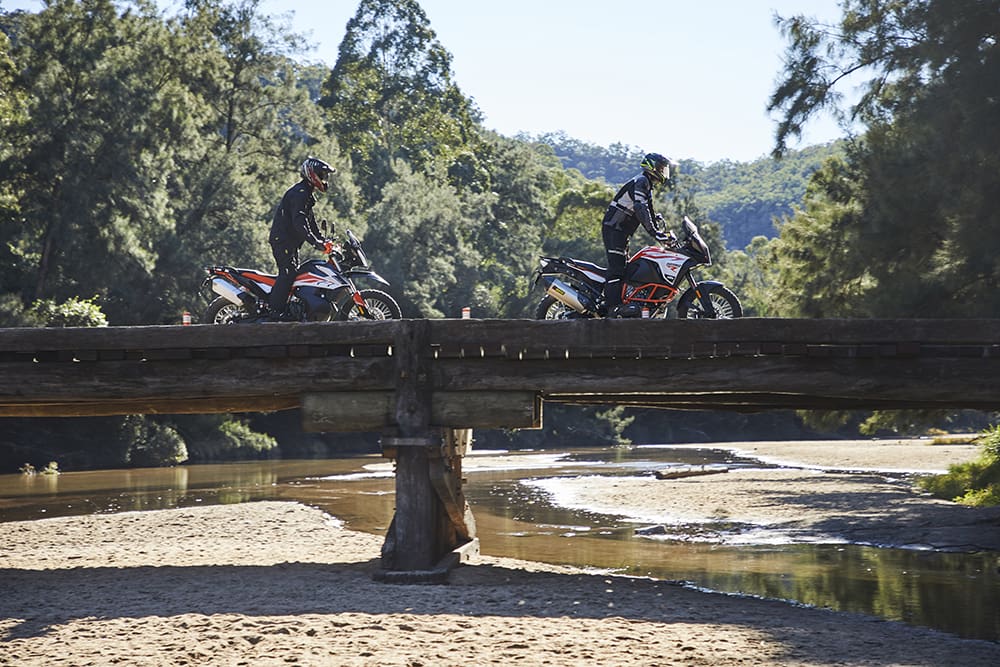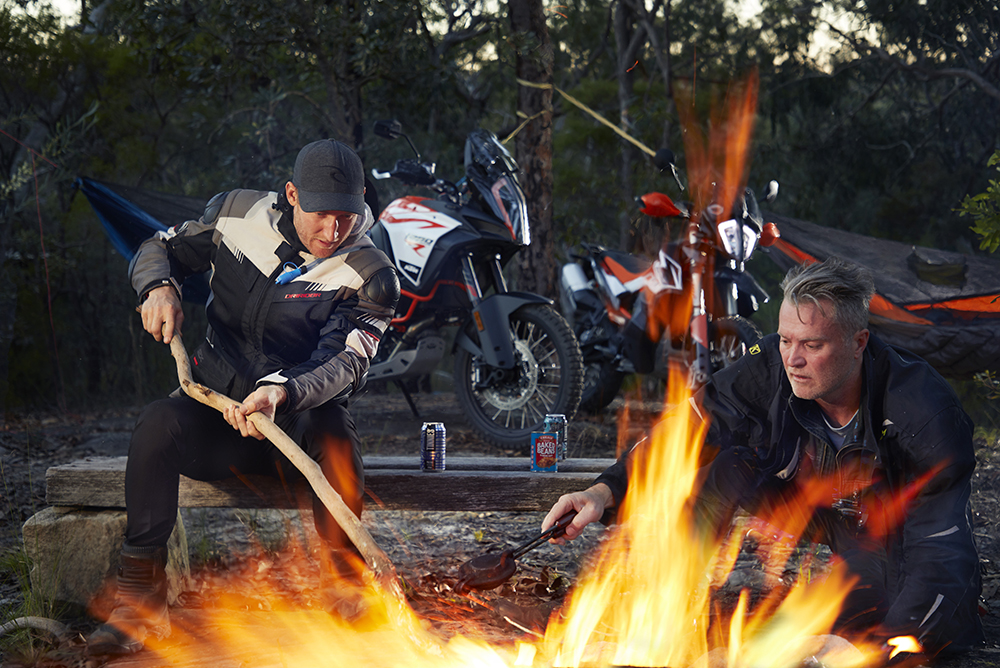Australia is the scorched motherland, home to some of the wildest adventure terrains in the world and a land full of opportunity for those who want to brave the elements, hit the open roads or go ‘walkabout’ on a motorcycle. Adventure riding for me is generally a standard mix of fast roads and gnarly dirt, followed by a pit stop at the bar to wash the dust down before a hot shower. But not this time. Unbeknownst to me, this time my adventure was defined by camping in a hammock – at a place that should have been named Funnel Web Central – in near 0ºC temperatures and where my pit stop consisted of a cold tin of baked beans with a side of fresh country air.
This trip was about getting to the nitty gritty in search of answers. Answers to the question, in a country where big-bore motorcycles have ruled the pointy end of the adventure segment for so long, why are the segment’s biggest players all of a sudden shouting about their new mid-capacity wares from the tree tops?
The adventure category offers so many possibilities in terms of both the machines available and the type of riding their owners do. Usually, it’s covering long distances on the route less travelled, ie, dirt. You need enough space to carry everything you need for a hiatus from reality and, when you’re not escaping said reality, you still need a versatile commuter that’s stylish and comfortable.
According to the official sales data for the first half of 2019, the best-selling adventure bike was Suzuki’s tried and trusted DR650SE, with 229 brand-new units sold. But at $8090, it’s clearly a price decision for most people rather than wanting a tech-heavy hard hitter of the adventure segment. The next best selling bike was BMW’s R 1250 GS Adventure, with 194 sales (while the regular GS version sold 155 in the same six months). Third was Honda’s 1000cc Africa Twin with 176 units, illustrating Australia’s love affair with large-capacity machinery.
The interesting bit was the fourth highest seller, KTM’s all-new, top-of-the-line 790 Adventure R. Here you have an innovative adventure machine, dripping with all the latest technology you’d expect from the Austrian brand, but powered by a 799cc parallel-twin engine – imagine using those last three words 10 years ago when describing the next big thing in adventure biking.
The thing had only been on sale for a few weeks when the data was complied, with a pricey but good value $22,695 (ride away) price tag, and the firm recorded 169 sales.
At AMCN, like most of Australia, we are big fans of large-capacity adventure bikes. But we want find to out if there’s anything more to the shift we predict is about to happen in the lucrative adventure bike segment, other than consumers wanting the latest and greatest.
For fairness and credibility, we needed to compare apples with apples, so instead of Beemer’s tech-heavy hard hitter, we called in KTM’s big daddy of adventure, the 1290 Adventure R, and its popular fresh-faced challenger, the 790 Adventure R, to do all the things we love about on- and off-road adventure riding – back-to-back.
After establishing base camp with a couple of hammocks slung between the trees in our short-term Funnel-Web infested home, the itinerary was finalised, the essentials loaded up, and we were ready for an early-morning departure. To make sure we had the best chance of getting the answers we needed, the route included the works; fast and twisty sealed sections, snotty asphalt b-roads, gravel roads – fast and slow – and plenty of gnarly, rocky single trails more suited to lightweight enduro bikes than $20K-plus adventure bikes…

The KTM 790 Adventure R is impressive and first impressions are exactly what you’d expect; a smaller version of the epic 1290 with the same level of quality that KTM offers throughout its entire adventure range.
The first and most notable point about the 790 is its weight. It’s light, low and at 189kg (dry), it feels just like a well-padded motocross bike. Then there’s the power; quite often these mid-sized bikes lack some poke in the forward direction, yet the 790 has way more get-up-and-go than its specs suggest. It boasts ‘only’ 70kW (94hp), but due to its low mass combined with decent torque, it has an abundance of go.
The biggest test however would be just how well it performed off road where, in sticky situations, any lacking in a bike’s performance stakes tend to rear its often ugly head. A good adventure bike needs to handle all manners of terrain, where surfaces are completely unpredictable and near crashes are, from time to time, inevitable.
But the 790 is one of the best balanced machines of any adventure bike on the market and handles all of these rough elements with relative ease. In these situations, a bike that carries its weight up high or towards the front, which is often the case, tends to plough through soft footings and can tuck the front wheel without too much warning. Not surprisingly, thanks to the innovative fuel tank design, which carries the liquid forward and low, the 790 felt as sure footed as a mountain goat.
Rear brake slides, spin turns and clutch pops over logs were far easier than they should be for an 800cc dual-sport machine. It felt controllable and compact, and made me look like a hero, which I didn’t mind one bit. It comes down to the feedback the 790 gives you, and both the suspension and seat height were another big boost in this area. The 880mm seat height is just about perfect for a tall rider like myself at 185cm; in fact, if anything it was a little low, but brilliant in the single-trail sections. And when I needed to stand up, the peg-to-bar ratio was roomy without making the cockpit feel overly spacious. The 790 R’s seat lacks the 20mm height adjustability of the standard 790 Adventure, but that model’s two-piece seat can be fitted to the R, and both higher and lower one-piece 790 R seats can be found in the firm’s bulging accessories catalogue.
Its electronics in Off-Road mode were excellent, allowing plenty of movement while still keeping things the right side of critical. Within it, KTM offers adjustable throttle response, which is both clever and useful. So not only does the system adjust the severity in which the power goes from your right hand to ground each time you switch between modes, but you can then toggle between each of the pre-set throttle response settings once you’re in a particular mode.
If everything gets turned off and no rider aids are active, just flicking the kill switch off and restarting the engine resets the ECU and all of the settings you turned off will come back on again. A little annoying if you stop to chat to your mate for just a minute, but kind of handy if you want to return to the default settings.
When it comes to full-blown adventure bikes, this bike is the real deal. It is so well thought out that it’s hard to fault; it’s as if KTM built this bike for Australian conditions.
The 790 was such a delight to ride, but notable that a lot of its success isn’t even due to a new or cutting-edge bit of tech, like some mythical chassis made of unobtanium. It’s just a really well-balanced and meticulously engineered machine that ticks the critical areas, which amounts to the next wave of top-end performance. With these key points considered and a smile from ear to ear, it was time for the challenger to step up.

KTM 1290 Adventure R
For the sake of transparency, I love this thing. Throwing a leg over the 1290 is nothing shy of thrilling and, while there are plenty of other big-bore, high-performance adventure bikes on the market, to me the 1290 R is pure Dakar.
It’s a cumbersome machine yet retains a well-balanced chassis, in part due to its stonking 1300cc V-twin engine nestled low and narrow in the frame. The 1290 is also naturally better suited to accommodate a larger-built rider and a pillion than its 790 counterpart, but it’s still relatively compact and its physical size isn’t overwhelming by any stretch.
Many of the features on the 1290 are common with the 790, yet it’s the ride that varies quite substantially. The best way to describe the feeling is that the 1290 R goes through the bumps rather than over them, and even though it has more chassis movement, it’s necessary with the 28 extra kilos the 1290 packs on board.
The 1290’s most notable feature is the incredible delivery of power and torque – if you haven’t sampled KTM’s 1301cc V-twin in any application, add it to your bucket list. KTM seems to have built what feels to be the same relative power output in the way it’s delivered into each of their adventures models, and just increased the amount with every jump in capacity.
It’s not often an adventure bike is this exciting when opening the gas, but the 1290 is something else! Intuitive and supremely capable, turn off all of the rider aids and it rides like a 230kg supermotard. It feels like it could possibly be related to those stadium super trucks that do massive jumps, it ploughed through bumpy back roads where many of its rivals would shake your fillings out and vibrate your hands off the bars.
To the confident off-roader, it’s a similar experience when the road gets loose, although the 1290’s weight is really apparent compared to the 790, and changing your course quickly over loose terrain needs far more physical input. In saying that, the 1290’s suspension continued to absorb the big hits like a cloud and the electronic rider aids are really well-adapted to the ride mode selected, so matching the aggression of the power delivery to the conditions is quick and simple.
The conventional fuel tank was really noticeable switching between machines, too. The 1290 carries its fuel on top of the engine, rather than adopting the 790’s clever either-side design, and in the same scenario tended to push the front end more on a loose surface. And while every bike has its pros and cons, the 1290 is still one of the biggest hitters in the big-bore category.

Back at Funnel Web Central and with plenty of kilometres under the belt on both the 790 and 1290, some trends had really started to make themselves clear to me. Having ridden each bike over the same terrain, there was no denying that KTM has consciously created two different machines for two different consumers, yet both machines were more than capable of doing the same job. This is a result of rapidly changing technology combined with consumers expecting more versatility from their machines, which is forcing manufacturers to continually improve their product.
A lot of people will agree that there’s no replacement for displacement, and the outright might of the 1290 is astounding. It closes the gap between an adventure bike and a big-bore street bike – the rush of torque from the big twin is thrilling in what is effectively a motocross bike on steroids. The on-road sections on one of the beefiest adventure bikes around were a hoot.
But that ballsy displacement also means a greater physical size and the associated weight that comes with it. It’s not that the bigger bikes are too big, it’s that the middleweight bikes are approaching the power of the old-generation kingpins we once deemed the ultimate tourers, but there’s a limit to how much power you can use and how much weight we want to carry. There is no doubt that the 1290 would be a better choice for carrying a mountain of luggage, or a pillion. And let’s face it, many of those big laps of the map are long days spent on tarmac or fast dirt roads, and a bike’s physical size doesn’t come into play.
The kicker is that the 790 is the result of advancements we are seeing with every new model and, as the tech advances, our need for more power, especially in the off road sector, is staying put. Weight reductions are usually one of the biggest improvements in terms of performance and the 790 has set a new benchmark, and not just a small weight saving compared to its competitors – a significant one that’s hard to ignore.
KTM is on the front foot, it has engineered a middleweight bike with plenty of power, light and nimble enough to tackle even the tightest of single trails and paired it with a suspension setup refined enough to perform on the black top as well as challenging dirt sections.
The market is changing and we’ve got one of the hottest middleweight bikes on the market available now. Even more exciting is this is only the beginning for KTM and its mid-sized pursuit!
So, what’ll it be?

There is no ‘winner’ as such because the 790 and 1290 are just too diverse. Each bike offers the rider something that the other bike can’t and while the 790 is a big step up for its category, there will be diehard fans of big bikes, who want the capacity bragging rights. Based on how each bike performed, the 1290 is going to suit the task of carrying heavier loads, regular two-up rides or long-haul mile munching on sealed or decent dirt.
In saying that, the 790 certainly doesn’t fall far from that tree and, while it can handle everything the 1290 can, its capabilities are going to suit the rider that wants to go a little deeper into the bush, the one who packs lighter and doesn’t mind revving the engine a little more to extract the power. It ultimately comes down to how much weight you want to sling around and if power is your ultimate thrill.
If you are thinking of making the switch and downsizing, don’t even consider the so-called backward step stigma that might come with smaller-capacity engine. As spiderman’s uncle said, “with great power comes great responsibility.”












